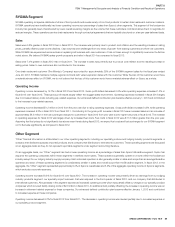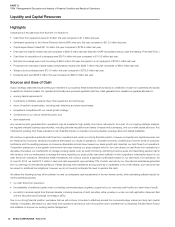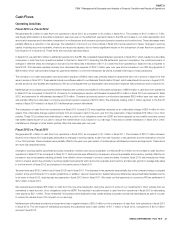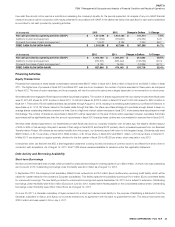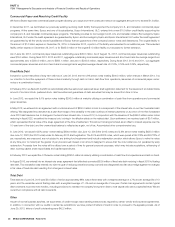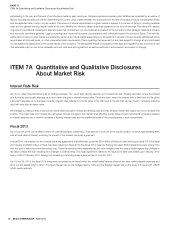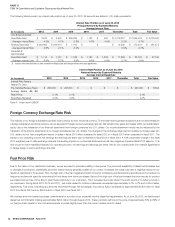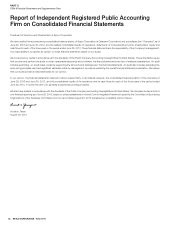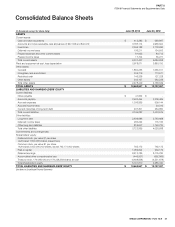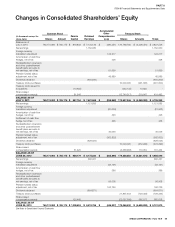Sysco 2013 Annual Report Download - page 50
Download and view the complete annual report
Please find page 50 of the 2013 Sysco annual report below. You can navigate through the pages in the report by either clicking on the pages listed below, or by using the keyword search tool below to find specific information within the annual report.
SYSCO CORPORATION-Form10-K 39
PARTII
ITEM7Management’s Discussion and Analysis of Financial Condition and Results of Operations
The compensation cost related to these share-based awards is recognized over the requisite service period. The requisite service period is generally the
period during which an employee is required to provide service in exchange for the award. The compensation cost related to stock issuances resulting
from employee purchases of stock under the Employees’ Stock Purchase Plan is recognized during the quarter in which the employee payroll withholdings
are made.
Our share-based awards are generally subject to graded vesting over a service period. We will recognize compensation cost on a straight-line basis over
the requisite service period for the entire award.
In addition, certain of ourshare-basedawards provide that the awards continue to vest as if the award holder continued to be an employee or director if
the award holder meets certain age and years of service thresholds upon retirement. In these cases, we will recognize compensation cost for such awards
over the period from the grant date to the date the employee or director rst becomes eligible to retire with the options continuing to vest after retirement.
Our option grants include options that qualify as incentive stock options for income tax purposes. In the period the compensation cost related to incentive
stock options is recorded, a corresponding tax bene t is not recorded as it is assumed that we will not receive a tax deduction related to such incentive
stock options. We may be eligible for tax deductions in subsequent periods to the extent that there is a disqualifying disposition of the incentive stock
option. In such cases, we would record a tax bene t related to the tax deduction in an amount not to exceed the corresponding cumulative compensation
cost recorded in the nancial statements on the particular options multiplied by the statutory tax rate.
Forward-Looking Statements
Certain statements made herein that look forward in time or express management’s expectations or beliefs with respect to the occurrence of future events
are forward-looking statements under the Private Securities Litigation Reform Act of 1995. They include statements about Sysco’s ability to increase its
sales and market share and grow earnings, expectations regarding pricing and margin pressure, cost per case reductions and sales case growth, the
continuing impact of economic conditions on consumer con dence and our business, sales and expense trends, including without limitation, expectations
regarding de ned contribution plan costs and pension costs, anticipated multiemployer pension related liabilities and contributions to various multiemployer
pension plans, expectations regarding potential payments of unrecognized tax bene ts and interest, expectations regarding share repurchases, dividend
payments, expected trends in fuel pricing, usage costs and surcharges, our expectation regarding the provision for losses on accounts receivable, expected
implementation, costs and bene ts of the ERP system, estimated expenses and capital expenditures related to our Business Transformation Project,
beliefs regarding future ERP conversions at our operating companies, expectations regarding our other Business Transformation initiatives including cost
transformation andproduct cost reduction and category management initiatives, beliefs regarding the timeline for the realization of bene ts from each of our
initiatives within our Business Transformation Project, expectation regarding the number of long-term contracts increasing as we progress with our category
management initiative, our plan to continue to explore and identify opportunities to grow in international markets and adjacent areas that complement our
core foodservice distribution business, expectations regarding future acquisitions and the contributions of acquisitions to our business and future revenues,
SYGMA’s growth prospects in scal 2014, the loss of SYGMA’s largest customer not having a material adverse effect on Sysco as a whole, compliance with
laws and government regulations not having a material effect on our capital expenditures, earnings or competitive position, anticipated acquisitions and
capital expenditures and the sources of nancing for them, continued competitive advantages and positive results from strategic initiatives, expectations
that depreciation and amortization expense will increase at a lower rate in scal 2014 than the rate in scal 2013, expectations that depreciation and
amortization expense will increase at a lower rate in scal 2014 than the rate in scal 2013, anticipated company-sponsored pension plan liabilities, our
expectations regarding cash ow from operations, our intentions regarding the repayment of debt, the impact of initiatives to improve working capital,
the availability and adequacy of insurance to cover liabilities, predictions regarding the impact of changes in estimates used in impairment analyses, the
anticipated impact of changes in foreign currency exchange rates and Sysco’s ability to meet future cash requirements.
These statements are based on management’s current expectations and estimates; actual results may differ materially due in part to the risk factors discussed
at Item1.A. in the Annual Report on Form10-K and elsewhere. In addition, the success of Sysco’s strategic initiatives could be affected by conditions in the
economy and the industry and internal factors such as the ability to control expenses, including fuel costs. Expected trends related to fuel costs and usage
are impacted by uctuations in the economy generally and numerous factors affecting the oil industry that are beyond our control. Our efforts to lower our
cost of goods sold may be impacted by factors beyond our control, including actions by our competitors and/or customers. We have experienced delays
in the implementation of our Business Transformation Project and the expected costs of our Business Transformation Project may be greater or less than
currently expected, as we may encounter the need for changes in design or revisions of the project calendar and budget. Our business and results of
operations may be adversely affected if we experience operating problems, scheduling delays, cost overages, or limitations on the extent of the business
transformation during the ERP implementation process. As implementation of the ERP system and other initiatives within the Business Transformation Project
begins, there may be changes in design or timing that impact near-term expense and cause us to revise the project calendar and budget, and additional
hiring and training of employees and consultants may be required, which could also impact project expense and timing. Our Business Transformation
Project initiatives related to ERP implementation, cost transformation and produce cost reduction may not provide the expected bene ts or cost savings
in a timely fashion, if at all. If we are unable to realize the anticipated bene ts from our cost cutting efforts, we could become cost disadvantaged in the
marketplace, and our competitiveness and our pro tability could decrease. De ned contribution plan costs are impacted by the number of employees


